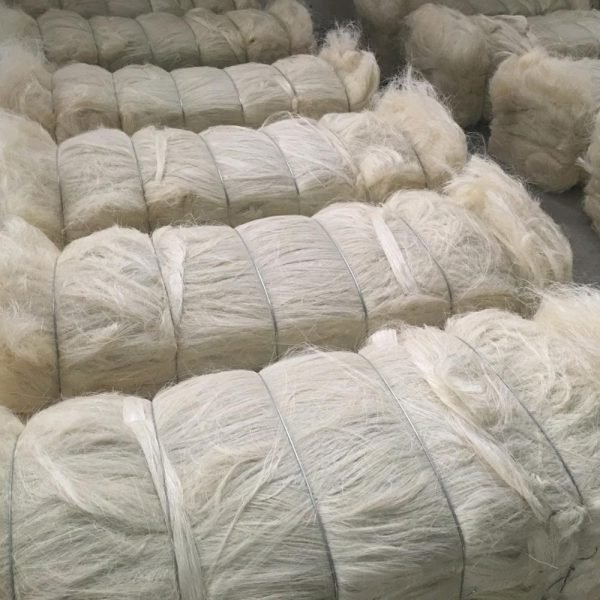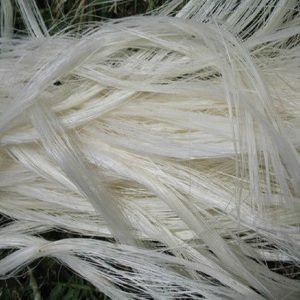Description
100% Natural sisal fiber
Sisal fiber is strong and pliable, wear-resisting, alkali-resisting, corrosion-resisting. Therefore, the sisal fiber rope can be applied in many fields like transportation, fishery, oil industry, metallurgy etc. sisal fiber from TANZANIA
Our sisal fiber is made from the high quality sisal hemp, which is strong enough. The sisal fiber can be used to produce many products, for example sisal rope, cable etc. The sisal fiber is with strong tenacity, good tension and pliable, high friction resistance, high acid and the sisal fiber is alkali-resisting to corrosiveness etc. The sisal fiber is widely used in making ropes, cores for steel wire rope, cable, polishing buff, carpet, pulp, building materials, doormat and other different kinds of products.
Sisal Fiber UG / SSUG Grades
Grades-UG / SSUG
Fiber Strength-=880N
Length- = 90cm -120cm
Trash ContentAbout-3%
Moisture Regain-11
Color- Cream white natural
Diameter-0.2mm – 0.4mm
Usage:Sisal cloth, sisal rope, sisal twine, cores for steel wire rope, sisal carpet, doormat, sisal polishing fabric
Sisal Fiber:
Sisal Fiber is one of the most widely used natural fiber and is very easily cultivated. It is obtain from sisal plant. The plant, known formally as Agave sisalana. These plants produce rosettes of sword-shaped leaves which start out toothed, and gradually lose their teeth with maturity. Each leaf contains a number of long, straight fibers which can be removed in a process known as decortication. During decortication, the leaves are beaten to remove the pulp and plant material, leaving the tough fibers behind. The fibers can be spun into thread for twine and textile production, or pulped to make paper products. Sisal is a leaf fiber and it is obtained from the leaves of agaves and also serves as strengthening component. Generally it is used for the production of cordage and ropes. Rarely used for fabric, other than packing materials and carpets.
Sisal fiber is fully biodegradable, green composites were fabricated with soy protein resin modified with gelatin. Sisal fiber, modified soy protein resins, and composites were characterized for their mechanical and thermal properties. It is highly renewable resource of energy. Sisal fiber is exceptionally durable and a low maintenance with minimal wear and tear. Its fiber is too tough for textiles and fabrics. It is not suitable for a smooth wall finish and also not recommended for wet areas. The sisal plant has a 7–10 years lifespan and typically produces 200–250 commercially usable leaves. Each leaf contains an average of around 1000 fibers. It is extracted by a process known as decortication.
The fine texture of sisal takes dyes easily and offers the largest range of dyed colors of all natural fibers. Zero pesticides or chemical fertilizers used in sisal agriculture. It is a stiff fiber traditionally used in making twine, rope and also dartboards sisal fiber is manufactured from the vascular tissue from the sisal plant (Agavesisalana). It is used in automotive friction parts (brakes, clutches), where it imparts green strength to performs, and for enhancing texture in coatings application.
Sisal fiber is derived from the leaves of the sisal plant. It is usually obtained by machine decortication in which the leaf is crushed between rollers and then mechanically scraped. The fiber is then washed and dried by mechanical or natural means. The dried fiber represents only 4 % of the total weight of the leaf. Once it is dried the fiber is mechanically double brushed. The lustrous strands, usually creamy white, average from 80 to 120 cm in length and 0.2 to 0.4 mm in diameter. Sisal fiber is fairly coarse and inflexible. It is valued for cordage (ropes, baler, binder twines, etc.) use because of its strength and durability. The higher-grade fiber after treatment is converted into yarns and used by the carpet industry. Sisal fiber is fairly coarse and inflexible. It is valued for cordage use because of its strength, durability, ability to stretch, affinity for certain dyestuffs and resistance to deterioration in saltwater.
Sisal is used by industry in three grades:
- The lower grade fiber is processed by the paper industry because of its high content of cellulose and hemicelluloses.
- The medium grade fiber is used in the cordage industry for making: ropes, baler and binders twine. Ropes and twines are widely employed for marine, agricultural and general industrial use.
- The higher-grade fiber after treatment is converted into yarns and used by the carpet industry.
General Properties of Sisal Fiber:
- Sisal Fiber is exceptionally durable with a low maintenance with minimal wear and tear.
- It is Recyclable.
- Sisal fibers are obtained from the outer leaf skin, removing the inner pulp.
- It is available as plaid, herringbone and twill.
- Sisal fibers are Anti static, does not attract or trap dust particles and does not absorb moisture or water easily.
- The fine texture takes dyes easily and offers the largest range of dyed colors of all natural fibers.
- It exhibits good sound and impact absorbing properties.
- Its leaves can be treated with natural borax for fire resistance properties.
Physical Properties of Sisal Fiber:
Physical properties of sisal fiber is explain below:
- Diameter —————— 22–80 μm
- Fiber length ————— 1000–1250 mm
- Density ——————– 1.16g / cm3
- Moisture regain ———- 11 %
- Breaking strength ——– 30–45 cN/tex
- Elongation —————- 2–3 %
Compression Properties of Sisal Fiber:
- Compression% ———— 9.578
- Recovery from Compression%————— 37.5
- Compression work (x102 J) —————— 1.59
- Recovery work from compression (x102 J) ——— 0.117
Chemical Composition of Sisal Fiber:
| Cellulose | 65% |
| Hemicelluloses | 12% |
| Lignin | 9.9% |
| Waxes | 2% |
| Total | 100% |
Identification of Sisal Fiber:
| Name of fiber | Fiber type | Flame reaction | Color | After Burn order |
| Sisal | Cellulose fiber | May flair when lit, burn | Soft gray ash | Burning paper or grass |
Structure of Sisal Fiber
Sisal fibers used for textile processing are multicellular fibers. In cross section, the fiber bundles are built up of about 100–200 single cells which are bonded together by natural gums. Single cells consist of thick walls with a central lumen and shape of single cell is polygonic. The cross section of sisal fibers is neither circular nor fairly uniform in dimension. The lumen varies in size but is usually well defined. Longitudinally the fiber is straight and without crimp, and approximately cylindrical in appearance. There are many knots and stripes on the surface of the fiber, which confirms that the fiber bundle is composed of many single cells which are arranged in straight parallel lines.
Processing of Sisal Fiber:
The processing technique employed is obviously dependent upon the end-use. The sisal fiber bundles can be spun into yarns by using traditional spinning processes, which include bale opening, mixing, cutting into staple fiber bundles, carding, drawing and sliver formation and spinning. The yarns can be then plied and twisted to form ropes and twines, as well as to produce woven fabrics for gunny bags. Long sisal fiber bundles can also be used directly in making ropes from slivers.
Uses / Application of Sisal Fiber:
From ancient times sisal has been the leading material for agricultural twine because of its strength, durability, ability to stretch, affinity for certain dyestuffs, and resistance to deterioration in saltwater.
- Sisal is used commonly in the shipping industry for mooring small craft, lashing, and handling cargo.
- It is also surprisingly used as the fiber core of the steel wire cables of elevators, being used for lubrication and flexibility purposes. Traditionally sisal was the leading material for agricultural twine or baler twine. Although this has now been overtaken by polypropylene.
- It is used in automobile industry with fiberglass in composite materials.
- Other products developed from sisal fiber include spa products, cat scratching posts, lumbar support belts, rugs, slippers, cloths and disc buffers.
- Sisal is used by itself in carpets or in blends with wool and acrylic for a softer hand.
- Sisal is also used for non-woven matting, brushing and roving.





Reviews
There are no reviews yet.